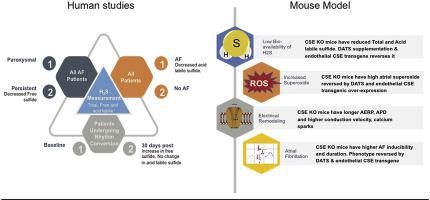Redox Biology ( IF 11.4 ) Pub Date : 2020-12-03 , DOI: 10.1016/j.redox.2020.101817 Megan Watts 1 , Gopi K Kolluru 2 , Parinita Dherange 1 , Sibile Pardue 2 , Man Si 3 , Xinggui Shen 2 , Krystle Trosclair 4 , John Glawe 2 , Zaki Al-Yafeai 2 , Mazen Iqbal 1 , Brenna H Pearson 2 , Kathryn A Hamilton 5 , A Wayne Orr 2 , Edward Glasscock 3 , Christopher G Kevil 2 , Paari Dominic 1

|
Oxidative stress drives the pathogenesis of atrial fibrillation (AF), the most common arrhythmia. In the cardiovascular system, cystathionine γ-lyase (CSE) serves as the primary enzyme producing hydrogen sulfide (H2S), a mammalian gasotransmitter that reduces oxidative stress. Using a case control study design in patients with and without AF and a mouse model of CSE knockout (CSE-KO), we evaluated the role of H2S in the etiology of AF. Patients with AF (n = 51) had significantly reduced plasma acid labile sulfide levels compared to patients without AF (n = 65). In addition, patients with persistent AF (n = 25) showed lower plasma free sulfide levels compared to patients with paroxysmal AF (n = 26). Consistent with an important role for H2S in AF, CSE-KO mice had decreased atrial sulfide levels, increased atrial superoxide levels, and enhanced propensity for induced persistent AF compared to wild type (WT) mice. Rescuing H2S signaling in CSE-KO mice by Diallyl trisulfide (DATS) supplementation or reconstitution with endothelial cell specific CSE over-expression significantly reduced atrial superoxide, increased sulfide levels, and lowered AF inducibility. Lastly, low H2S levels in CSE KO mice was associated with atrial electrical remodeling including longer effective refractory periods, slower conduction velocity, increased myocyte calcium sparks, and increased myocyte action potential duration that were reversed by DATS supplementation or endothelial CSE overexpression. Our findings demonstrate an important role of CSE and H2S bioavailability in regulating electrical remodeling and susceptibility to AF.
中文翻译:

硫化氢生物利用度降低与心房颤动中的血管内皮和心房重构有关
氧化应激驱动心房颤动 (AF) 的发病机制,这是最常见的心律失常。在心血管系统中,胱硫醚 γ-裂合酶 (CSE) 是产生硫化氢 (H 2 S) 的主要酶,硫化氢是一种哺乳动物气体递质,可减少氧化应激。我们使用有和无 AF 患者的病例对照研究设计和 CSE 敲除小鼠模型 (CSE-KO),评估了 H 2 S 在 AF 病因学中的作用。与没有 AF 的患者 (n = 65) 相比,患有 AF 的患者 (n = 51) 的血浆酸不稳定硫化物水平显着降低。此外,与阵发性 AF 患者 (n = 26) 相比,持续性 AF 患者 (n = 25) 的血浆游离硫化物水平较低。与 H 2的重要作用一致在 AF 中,与野生型 (WT) 小鼠相比,CSE-KO 小鼠的心房硫化物水平降低,心房超氧化物水平升高,诱发持续性 AF 的倾向增强。通过补充二烯丙基三硫化物 (DATS) 或用内皮细胞特异性 CSE 过表达重建 CSE-KO 小鼠中的H 2 S 信号传导,可显着降低心房超氧化物、增加硫化物水平并降低 AF 诱导性。最后,低 H 2CSE KO 小鼠中的 S 水平与心房电重构相关,包括更长的有效不应期、更慢的传导速度、增加的肌细胞钙火花和增加的肌细胞动作电位持续时间,这些被 DATS 补充或内皮 CSE 过表达逆转。我们的研究结果表明 CSE 和 H 2 S 生物利用度在调节电重构和 AF 易感性中的重要作用。

























 京公网安备 11010802027423号
京公网安备 11010802027423号